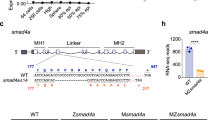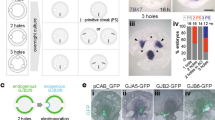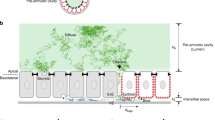Abstract
Patterning the embryonic dorsoventral axis of both vertebrates and invertebrates requires signalling through bone morphogenetic proteins (BMPs)1. Although a well-studied process, the identity of the physiologically relevant BMP signalling complex in the Drosophila melanogaster embryo is controversial2,3, is generally inferred from cell culture studies and has not been investigated in vertebrates. Here, we demonstrate that dorsoventral patterning in zebrafish, Danio rerio, requires two classes of non-redundant type I BMP receptors, Alk3/6 and Alk8 (activin-like kinases 3/6 and 8). We show, under physiological conditions in the embryo, that these two type I receptor classes form a complex in a manner that depends on Bmp2 and Bmp7. We found that both Bmp2–7 heterodimers, as well as Bmp2 and Bmp7 homodimers, form in the embryo. However, only recombinant ligand heterodimers can activate BMP signalling in the early embryo, whereas a combination of Bmp2 and Bmp7 homodimers cannot. We propose that only heterodimers, signalling through two distinct classes of type I receptor, possess sufficient receptor affinity in an environment of extracellular antagonists to elicit the signalling response required for dorsoventral patterning.
This is a preview of subscription content, access via your institution
Access options
Subscribe to this journal
Receive 12 print issues and online access
$209.00 per year
only $17.42 per issue
Buy this article
- Purchase on Springer Link
- Instant access to full article PDF
Prices may be subject to local taxes which are calculated during checkout





Similar content being viewed by others
Accession codes
References
Little, S. C. & Mullins, M. C. Extracellular modulation of BMP activity in patterning the dorsoventral axis. Birth Defects Res. C Embryo Today 78, 224–242 (2006).
Shimmi, O., Umulis, D., Othmer, H. & O'Connor, M. B. Facilitated transport of a Dpp/Scw heterodimer by Sog/Tsg leads to robust patterning of the Drosophila blastoderm embryo. Cell 120, 873–886 (2005).
Wang, Y. C. & Ferguson, E. L. Spatial bistability of Dpp-receptor interactions during Drosophila dorsal-ventral patterning. Nature 434, 229–234 (2005).
Feng, X. H. & Derynck, R. Specificity and versatility in TGF-β signaling through Smads. Annu. Rev. Cell Dev. Biol. 21, 659–693 (2005).
O'Connor, M. B., Umulis, D., Othmer, H. G. & Blair, S. S. Shaping BMP morphogen gradients in the Drosophila embryo and pupal wing. Development 133, 183–193 (2006).
Kishigami, S. & Mishina, Y. BMP signaling and early embryonic patterning. Cytokine Growth Factor Rev. 16, 265–278 (2005).
Schmid, B. et al. Equivalent genetic roles for bmp7/snailhouse and bmp2b/swirl in dorsoventral pattern formation. Development 127, 957–967 (2000).
Yelick, P. C., Abduljabbar, T. S. & Stashenko, P. zALK-8, a novel type I serine/threonine kinase receptor, is expressed throughout early zebrafish development. Dev. Dyn. 211, 352–361 (1998).
Nikaido, M., Tada, M., Takeda, H., Kuroiwa, A. & Ueno, N. In vivo analysis using variants of zebrafish BMPR-IA: range of action and involvement of BMP in ectoderm patterning. Development 126, 181–190 (1999).
Nikaido, M., Tada, M. & Ueno, N. Restricted expression of the receptor serine/threonine kinase BMPR-IB in zebrafish. Mech. Dev. 82, 219–222 (1999).
Woods, I. G. et al. The zebrafish gene map defines ancestral vertebrate chromosomes. Genome Res. 15, 1307–1314 (2005).
Bauer, H., Lele, Z., Rauch, G. J., Geisler, R. & Hammerschmidt, M. The type I serine/threonine kinase receptor Alk8/Lost-a-fin is required for Bmp2b/7 signal transduction during dorsoventral patterning of the zebrafish embryo. Development 128, 849–858 (2001).
Mintzer, K. A. et al. Lost-a-fin encodes a type I BMP receptor, Alk8, acting maternally and zygotically in dorsoventral pattern formation. Development 128, 859–869 (2001).
Mullins, M. C. et al. Genes establishing dorsoventral pattern formation in the zebrafish embryo: the ventral specifying genes. Development 123, 81–93 (1996).
Imai, Y. & Talbot, W. S. Morpholino phenocopies of the bmp2b/swirl and bmp7/snailhouse mutations. Genesis 30, 160–163 (2001).
Sampath, T. K. et al. Bovine osteogenic protein is composed of dimers of OP-1 and BMP-2A, two members of the transforming growth factor-β superfamily. J. Biol. Chem. 265, 13198–13205 (1990).
Cui, Y., Jean, F., Thomas, G. & Christian, J. L. BMP-4 is proteolytically activated by furin and/or PC6 during vertebrate embryonic development. EMBO J. 17, 4735–4743 (1998).
Tucker, J. A., Mintzer, K. A. & Mullins, M. C. The BMP signaling gradient patterns dorsoventral tissues in a temporally progressive manner along the anteroposterior axis. Dev. Cell 14, 108–119 (2008).
Yeo, C. & Whitman, M. Nodal signals to Smads through Cripto-dependent and Cripto-independent mechanisms. Mol. Cell 7, 949–957 (2001).
Gilboa, L., Wells, R. G., Lodish, H. F. & Henis, Y. I. Oligomeric structure of type I and type II transforming growth factor β receptors: homodimers form in the ER and persist at the plasma membrane. J. Cell Biol. 140, 767–777 (1998).
Gilboa, L. et al. Bone morphogenetic protein receptor complexes on the surface of live cells: a new oligomerization mode for serine/threonine kinase receptors. Mol. Biol. Cell 11, 1023–1035 (2000).
Graff, J. M., Thies, R. S., Song, J. J., Celeste, A. J. & Melton, D. A. Studies with a Xenopus BMP receptor suggest that ventral mesoderm-inducing signals override dorsal signals in vivo. Cell 79, 169–179 (1994).
Koenig, B. B. et al. Characterization and cloning of a receptor for BMP-2 and BMP-4 from NIH 3T3 cells. Mol. Cell. Biol. 14, 5961–5974 (1994).
Kirsch, T., Nickel, J. & Sebald, W. BMP-2 antagonists emerge from alterations in the low-affinity binding epitope for receptor BMPR-II. EMBO J. 19, 3314–3324 (2000).
Macias-Silva, M., Hoodless, P. A., Tang, S. J., Buchwald, M. & Wrana, J. L. Specific activation of Smad1 signaling pathways by the BMP7 type I receptor, ALK2. J. Biol. Chem. 273, 25628–25636 (1998).
Greenwald, J. et al. The BMP7/ActRII extracellular domain complex provides new insights into the cooperative nature of receptor assembly. Mol. Cell 11, 605–617 (2003).
Scheufler, C., Sebald, W. & Hulsmeyer, M. Crystal structure of human bone morphogenetic protein-2 at 2.7 A resolution. J. Mol. Biol. 287, 103–115 (1999).
Weber, D. et al. A silent H-bond can be mutationally activated for high-affinity interaction of BMP-2 and activin type IIB receptor. BMC Struct. Biol. 7, 6 (2007).
Aono, A. et al. Potent ectopic bone-inducing activity of bone morphogenetic protein-4/7 heterodimer. Biochem. Biophys. Res. Commun. 210, 670–677 (1995).
Suzuki, A., Kaneko, E., Ueno, N. & Hemmati-Brivanlou, A. Regulation of epidermal induction by BMP2 and BMP7 signaling. Dev. Biol. 189, 112–122 (1997).
Nishimatsu, S. & Thomsen, G. H. Ventral mesoderm induction and patterning by bone morphogenetic protein heterodimers in Xenopus embryos. Mech. Dev. 74, 75–88 (1998).
Khokha, M. K., Yeh, J., Grammer, T. C. & Harland, R. M. Depletion of three BMP antagonists from Spemann's organizer leads to a catastrophic loss of dorsal structures. Dev. Cell 8, 401–411 (2005).
Dal-Pra, S., Furthauer, M., Van-Celst, J., Thisse, B. & Thisse, C. Noggin1 and Follistatin-like2 function redundantly to Chordin to antagonize BMP activity. Dev Biol. 298, 514–526 (2006).
Piccolo, S., Sasai, Y., Lu, B. & De Robertis, E. M. Dorsoventral patterning in Xenopus: inhibition of ventral signals by direct binding of chordin to BMP-4. Cell 86, 589–598 (1996).
Zimmerman, L. B., De Jesus-Escobar, J. M. & Harland, R. M. The Spemann organizer signal noggin binds and inactivates bone morphogenetic protein 4. Cell 86, 599–606 (1996).
Piccolo, S. et al. The head inducer Cerberus is a multifunctional antagonist of Nodal, BMP and Wnt signals. Nature 397, 707–710 (1999).
Piccolo, S. et al. Cleavage of Chordin by Xolloid metalloprotease suggests a role for proteolytic processing in the regulation of Spemann organizer activity. Cell 91, 407–416 (1997).
De Robertis, E. M. Spemann's organizer and self-regulation in amphibian embryos. Nat Rev Mol Cell Biol. 7, 296–302 (2006).
Nguyen, V. H. et al. Dorsal and intermediate neuronal cell types of the spinal cord are established by a BMP signaling pathway. Development 127, 1209–1220 (2000).
Nguyen, V. H. et al. Ventral and lateral regions of the zebrafish gastrula, including the neural crest progenitors, are established by a bmp2b/swirl pathway of genes. Dev Biol. 199, 93–110 (1998).
Padgett, K. A. & Sorge, J. A. Creating seamless junctions independent of restriction sites in PCR cloning. Gene 168, 31–35 (1996).
Robu, M. E. et al. p53 activation by knockdown technologies. PLoS Genet. 3, e78 (2007).
Little, S. C. & Mullins, M. C. Twisted gastrulation promotes BMP signaling in zebrafish dorsal-ventral axial patterning. Development 131, 5825–5835 (2004).
Nasevicius, A. & Ekker, S. C. Effective targeted gene 'knockdown' in zebrafish. Nat Genet. 26, 216–20 (2000).
Acknowledgements
We thank M. Whitman for the Alk4(KR)HA construct; L. Jing and M. Granato for Myc-tagged Unplugged/MuSK; B. Holloway and J. Tucker for technical advice; S. Lu for technical support; J. Xie and the UPenn zebrafish core facility for wild-type embryos and S. DiNardo, T. Gupta, F. Marlow and L. Kapp for comments on the manuscript. This work was funded by NIH grants to M.C.M. (GM56326) and to S.C.L. (5 T32 GM07229-28 and 2 T32 HD007516-05).
Author information
Authors and Affiliations
Contributions
S.C.L. performed the experiments. S.C.L. and M.C.M. designed the experiments, analysed the data, and wrote the manuscript.
Corresponding author
Ethics declarations
Competing interests
The authors declare no competing financial interests.
Supplementary information
Supplementary Information
Supplementary Information (PDF 1110 kb)
Rights and permissions
About this article
Cite this article
Little, S., Mullins, M. Bone morphogenetic protein heterodimers assemble heteromeric type I receptor complexes to pattern the dorsoventral axis. Nat Cell Biol 11, 637–643 (2009). https://doi.org/10.1038/ncb1870
Received:
Accepted:
Published:
Issue Date:
DOI: https://doi.org/10.1038/ncb1870
This article is cited by
-
Highly conserved and extremely evolvable: BMP signalling in secondary axis patterning of Cnidaria and Bilateria
Development Genes and Evolution (2024)
-
Lumbar spine intervertebral disc gene delivery of BMPs induces anterior spine fusion in lewis rats
Scientific Reports (2022)
-
Sexual determination in zebrafish
Cellular and Molecular Life Sciences (2022)
-
Generation of extracellular morphogen gradients: the case for diffusion
Nature Reviews Genetics (2021)
-
BMP10-mediated ALK1 signaling is continuously required for vascular development and maintenance
Angiogenesis (2020)



